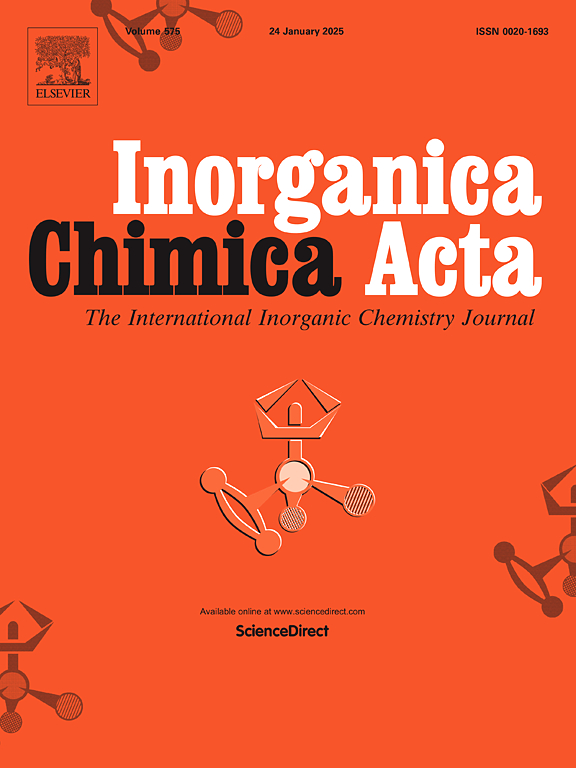以顺式-[Ru(2,2 ':6 ‘,2″-三联吡啶)(NCCH3)2Cl]+为中间体合成[Ru(2,2 ’:6 ‘,2″-三联吡啶)Cl]+配合物的新方法,并与以[Ru(苯)(2,2 ’ -联吡啶)Cl]+为中间体的方法进行比较
IF 3.2
3区 化学
Q2 CHEMISTRY, INORGANIC & NUCLEAR
引用次数: 0
摘要
报道了以顺式-[Ru(terpy)(NCCH3)2Cl](PF6)为原料合成[Ru(terpy)(bpy)Cl]+ (terpy = 2,2′:6′,2″-联吡啶,bpy = 2,2′-联吡啶)配合物的新方法。四种衍生物[Ru(terpy)(NN)Cl](PF6)的产率:NN = bpy, 1;4, 4’- (MeO) 2 bpy, 2;4, 4’-(恶)2 bpy, 3;2,2 ' -双喹啉,4)在此方法下的反应范围为58%至94%,与已知的以[Ru(苯)(NN)Cl](PF6)为起始物质的反应相似或更高。然而,使用顺式-[Ru(terpy)(NCCH3)2Cl](PF6)与使用[Ru(苯)(bpy)Cl](PF6)相比,在1的合成中使用顺式-[Ru(terpy)(NCCH3)2Cl](PF6)导致较低水平的同感钌副产物。此外,与文献中披露的原始合成相比,报道了一种不使用柱层析的高纯度和克级的顺式-[Ru(terpy)(NCCH3)2Cl](PF6)的合成。本文章由计算机程序翻译,如有差异,请以英文原文为准。
![A new synthetic method of [Ru(2,2′:6′,2″-terpyridine)(2,2′-bipyridine)Cl]+ complexes using cis-[Ru(2,2′:6′,2″-terpyridine)(NCCH3)2Cl]+ as an intermediate and comparison to a method using [Ru(benzene)(2,2′-bipyridine)Cl]+ intermediates](https://img.booksci.cn/booksciimg/2025-9/104309414911790507684.jpg)
A new synthetic method of [Ru(2,2′:6′,2″-terpyridine)(2,2′-bipyridine)Cl]+ complexes using cis-[Ru(2,2′:6′,2″-terpyridine)(NCCH3)2Cl]+ as an intermediate and comparison to a method using [Ru(benzene)(2,2′-bipyridine)Cl]+ intermediates
A new method of synthesizing [Ru(terpy)(bpy)Cl]+ (terpy = 2,2′:6′,2″-terpyridine, bpy = 2,2′-bipyridine) complexes using the starting material cis-[Ru(terpy)(NCCH3)2Cl](PF6) is reported. The yields of four derivatives ([Ru(terpy)(NN)Cl](PF6): NN = bpy, 1; 4,4′-(MeO)2bpy, 2; 4,4′-(CF3)2bpy, 3; 2,2′-biquinoline, 4) with this method range from 58 to 94 % and are similar to or greater than a known reaction in which the starting material is [Ru(benzene)(NN)Cl](PF6). However, the use of cis-[Ru(terpy)(NCCH3)2Cl](PF6) results in lower levels of homoleptic Ru byproducts in the synthesis of 1 as compared to the use of [Ru(benzene)(bpy)Cl](PF6) as determined by 1H NMR spectroscopy. Additionally, a high-purity and gram-scale synthesis of cis-[Ru(terpy)(NCCH3)2Cl](PF6) that does not use column chromatography is reported, in contrast to the original synthesis disclosed in the literature.
求助全文
通过发布文献求助,成功后即可免费获取论文全文。
去求助
来源期刊

Inorganica Chimica Acta
化学-无机化学与核化学
CiteScore
6.00
自引率
3.60%
发文量
440
审稿时长
35 days
期刊介绍:
Inorganica Chimica Acta is an established international forum for all aspects of advanced Inorganic Chemistry. Original papers of high scientific level and interest are published in the form of Articles and Reviews.
Topics covered include:
• chemistry of the main group elements and the d- and f-block metals, including the synthesis, characterization and reactivity of coordination, organometallic, biomimetic, supramolecular coordination compounds, including associated computational studies;
• synthesis, physico-chemical properties, applications of molecule-based nano-scaled clusters and nanomaterials designed using the principles of coordination chemistry, as well as coordination polymers (CPs), metal-organic frameworks (MOFs), metal-organic polyhedra (MPOs);
• reaction mechanisms and physico-chemical investigations computational studies of metalloenzymes and their models;
• applications of inorganic compounds, metallodrugs and molecule-based materials.
Papers composed primarily of structural reports will typically not be considered for publication.
 求助内容:
求助内容: 应助结果提醒方式:
应助结果提醒方式:


